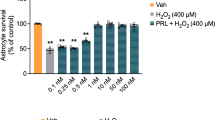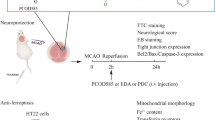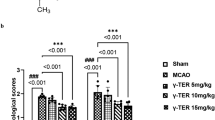Abstract
In response to oxidative stress, the ischemic brain induces immediate early genes when its nuclear genes contain gene damage. Antioxidant that reduces gene damage also reduces cell death. To study the mechanism of neuronal sensitivity, we investigated the transcription of the c-fos gene after brain injury of the ischemia-reperfusion type using focal cerebral ischemia-reperfusion in Long-Evans hooded rats. We observed a significant (p<0.01) increase in c-fos mRNA in the ischemic cortex immediately after brain injury. However, the c-fos transcript was sensitive to RNase A protection assay (RPA) upon reperfusion. The transcript became significantly resistant to RPA (42%, p<0.03) when 3-bromo-7-nitroindazole (25 mg/kg, i.p.), known to abolish nitric oxide, gene damage and neuronal sensitivity, was injected. Our data suggest that neuronal nitric oxide synthase and aberrant mRNA from genes with oxidative damage could be associated with neuronal sensitivity.
Similar content being viewed by others
References
Akins PT, Liu PK, Hsu CY. Immediate early gene expression in response to cerebral ischemia. Friend or foe? Stroke 27:1682–1687;1996.
Ayata C, Ayata G, Hara H, Matthews RT, Beal MF, Ferrante RJ, Endres M, Kim A, Christie RH, Waeber C, Huang PL, Hyman BT, Moskowitz MA. Mechanisms of reduced striatal NMDA excitotoxicity in type I nitric oxide synthase knock-out mice. J Neurosci 17:6908–6917;1997.
Cui JK, Holmes EH, Cao ST, Greene TG, Liu PK. Oxidative DNA damage precedes DNA fragmentation after experimental stroke in rat brain. FASEB J 14:955–967;2000.
Cui JK, Holmes EH, Liu PK. Oxidative damage to the c-fos gene and reduction of its transcription after focal cerebral ischemia. J Neurochem 73:1164–1174;1999.
Cui JK, Hsu CY, Liu PK. Suppression of post-ischemic hippocampal nerve growth factor expression by a c-fos antisense oligodeoxynucleotide. J Neurosci 19:2784–2893;1999.
Deng X, Ladenheim B, Tsao LI, Cadet JL. Null mutation of c-fos causes exacerbation of methamphetamine-induced neurotoxicity. J Neurosci 19:10107–10115;1999.
Du C, Hu R, Csernansky CA, Hsu CY, Choi DW. Very delayed infarction after mild focal cerebral ischemia: A role for apoptosis? J Cereb Blood Flow Metab 16:195–201;1996.
Dugan LL, Creedon DJ, Johnson EM Jr, Holtzman DM. Rapid suppression of free radical formation by nerve growth factor involves the mitogen-activated protein kinase pathway. Proc Natl Acad Sci USA 94:4086–4091;1997.
Estus S, Zaks WJ, Freeman RS, Gruda M, Bravo R, Johnson EM Jr. Altered gene expression in neurons during programmed cell death: Identification of c-jun as necessary for neuronal apoptosis. J Cell Biol 127:1717–1727;1994.
Gavrieli Y, Sherman Y, Ben-Sasson SA. Identification of programmed cell death in situ via specific labeling of nuclear DNA fragmentation. J Cell Biol 119:493–501;1992.
Hall ED, Braughler JM. Central nervous system trauma and stroke. II. Physiological and pharmacological evidence for involvement of oxygen radicals and lipid peroxidation. Free Radic Biol Med 6:303–313;1989.
Hengerer B, Lindholm D, Heumann R, Ruther UU, Wagner EF, Thoenen H. Lesion-induced increase in nerve growth factor mRNA is mediated by c-fos. Proc Natl Acad Sci USA 87:3899–3903;1990.
Horigome K, Bullock ED, Johnson EM Jr. Effects of nerve growth factor on rat peritoneal mast cells. Survival promotion and immediate-early gene induction. J Biol Chem 269:2695–2702;1994.
Huang D, Shenoy A, Huang W, Cao S, Cui J, Liu PK. In situ detection of AP sites and DNA single stranded breaks with 3′-phosphate terminus in cerebral ischemia-reperfusion. FASEB J 14:407–417;2000.
Iadecola C, Zhang F, Casey R, Nagayama M, Ross ME. Delayed reduction of ischemia brain injury and neurological deficits in mice lacking the inducible nitric oxide synthase gene. J Neurosci 23:9157–9164;1997.
Jenner P, Dexter DT, Sian J, Schapira AH, Marsden CD. Oxidative stress as a cause of nigral cell death in Parkinson's disease and incidental Lewy body disease. The Royal Kings and Queens Parkinson's Disease Research Group. Ann Neurol 32(suppl):S82-S87;1992.
Kamii H, Mikawa S, Murakami K, Kinouchi H, Yoshimoto T, Reola L, Carlson E, Epstein CJ, Chan PH. Effects of nitric oxide synthase inhibition on brain infraction in SOD-1-transgenic mice following transient focal cerebral ischemia. J Cereb Blood Flow Metab 16:1153–1157;1994.
Lerant A, Freeman ME. Dopaminergic neurons in periventricular and arcuate nuclei of proestrous and ovariectomized rats: Endogenous diurnal rhythm of Fos-related antigens expression. Neuroendocrinology 65:436–445;1997.
Lewen A, Matz P, Chan P. Free radical pathways in CNS injury. J Neurotrauma 17:871–890;2000.
Li Y, Chopp M, Jiang N, Zaloga C. In situ detection of DNA fragmentation after focal cerebral ischemia in mice. Brain Res Mol Brain Res 28:164–168;1995.
Lin L, Cao S, Yu L, Cui J, Hamilton WJ, Liu PK. Up-regulation of base excision repair activity for 8-hydroxy-2′deoxyguanosine in the mouse brain after forebrain ischemia-reperfusion. J Neurochem 74:1098–1105;2000.
Lipton P. Ischemic cell death in brain neurons. Physiol Rev 79:1431–1568;1999.
Liu PK, Cui JK. Expression of aberrant messenger RNA during oxidative stress in the mouse brain: Transcription activators from nuclear genes that are damaged, submitted.
Liu PK, Hsu CY, Dizdaroglu M, Floyd RA, Kow YW, Karakaya A, Rabow LE, Cui JK. Damage, repair and mutagenesis in nuclear genes after mouse forebrain ischemia-reperfusion. J Neurosci 16:6795–6806;1996.
Liu PK, Salminen A, He YY, Jiang MH, Xue JJ, Liu JS, Hsu CY. Suppression of ischemia-induced Fos expression and AP-1 activity by an antisense oligodeoxynucleotide to c-fos mRNA. Ann Neurol 36:566–576;1994.
Mecocci P, MacGarvey U, Beal MF. Oxidative damage to mitochondrial DNA is increased in Alzheimer's disease. Ann Neurol 36:747–751;1994.
Mecocci P, MacGarvey U, Kaufman AE, Koontz D, Shoffner JM, Wallace DC, Beal MF. Oxidative damage to mitochondrial DNA shows marked age-dependent increases in human brain. Ann Neurol 34:609–616;1993.
Namura S, Zhu J, Fink K, Endres M, Srinivasan A, Tomaselli KJ, Yuan J, Moskowitz MA. Activation and cleavage of caspase-3 in apoptosis induced by experimental cerebral ischemia. J Neurosci 18:3659–3668;1998.
Nunomura A, Perry G, Pappolla MA, Wade R, Hirai K, Chiba S, Smith M. RNA oxidation is a prominent feature of vulnerable neurons in Alzheimer's disease. J Neurosci 19:1959–1964;1999.
O'Neill MJ, Hicks C, Ward M. Neuroprotective effects of 7-nitroindazole in the gerbil model of global cerebral ischemia. Eur J Pharmacol 310:115–122;1996.
Parshad R, Sanford KK, Price FM. Fluorescence light-induced chromatid breaks distinguish Alzheimer disease cells from normal cells in tissue culture. Proc Natl Acad Sci USA 93:5146–5150;1996.
Pennypacker KR, Thai L, Hong JS, McMillian MK. Prolonged expression of AP-1 transcription factors in the rat hippocampus after systemic kainate treatment. J Neurosci 14:3998–4006;1994.
Petito CK, Torres-Munoz J, Roberts B, Olarte JP, Nowak TS Jr, Pulsinelli WA. DNA fragmentation follows delayed neuronal death in CA1 neurons exposed to transient global ischemia in the rat. J Cereb Blood Flow Metab 17:967–976;1997.
Reardon JT, Bessho T, Kung HC, Bolton PH, Sancar A. In vitro repair of oxidative DNA damage by human nucleotide excision repair system: Possible explanation for neurodegeneration in xeroderma pigmentosum patients. Proc Natl Acad Sci USA 94:9463–9468;1997.
Robbins JH, Brumback RA, Polinsky RJ, Wirtschafter JD, Tarone RE, Scudiero DA, Otsuka F. Hypersensitivity to DNA-damaging agents in abiotrophies: A new explanation for degeneration of neurons, photoreceptors, and muscle in Alzheimer, Parkinson, and Huntington diseases, retinitis pigmentosa, and Duchenne muscular dystrophy. Basic Life Sci 35:315–344;1985.
Robbins JH, Otsuka F, Tarone RE, Polinsky RJ, Brumback RA, Moshell AN, Nee LE, Ganges MB, Cayeux SJ. Radiosensitivity in Alzheimer disease and Parkinson disease. Lancet i:468–469;1983.
Robbins JH, Scudiero DA, Otsuka F, Tarone RE, Brumback RA, Wirtschafter JD, Polinsky RJ, Barrett SF, Moshell AN, Scarpinat RG. Hypersensitivity to DNA-damaging agents in cultured cells from patients with Usher's syndrom and Duchenne muscular dystrophy. J Neurol Neurosurg Psychiatry 47:391–398;1984.
Sagar SM, Sharp FR, Curran T. Expression of c-fos protein in brain: Metabolic mapping at the cellular level. Science 240:1328–1331;1988.
Salminen A, Liu PK, Hsu CY. Alteration of transcription factor binding activities in the ischemic rat brain. Biochem Biophys Res Commun 212:939–944;1995.
Scanlon KJ, Jiao L, Funato T, Wang W, Tine T, Rossi JJ, Kashani-Sabet M. Ribozyme-mediated cleavage of c-fos mRNA reduces gene expression of DNA synthesis enzymes and metallothionein. Proc Natl Acad Sci USA 88:10591–10595;1991.
Schulz JB, Mathews RT, Jenkins BG, Ferrante RJ, Siwek D, Henshaw DR, Cipolloni PB, Mecocci P, Kowall NW, Rosen BR, Beal MF. Blockade of neuronal nitric oxide synthase protects against excitotoxicity in vivo. J Neurosci 15:8419–8429;1995.
Sharp FR, Massa SM, Swanson RA. Heatshock protein protection. Trends Neurosci 22:97–99;1999.
Shioda S, Funahashi H, Nakajo S, Yada T, Maruta O, Nakai Y. Immunohistochemical localization of leptin receptor in the rat brain. Neurosci Lett 243:41–44;1998.
Strauss S, Otten U, Joggerst B, Pluss K, Volk B. Increased levels of nerve growth factor (NGF) protein and mRNA and reactive gliosis following kainic acid injection into the rat striatum. Neurosci Lett 168:193–196;1994.
Tammariello S, Quinn MT, Estus S. NADPH oxidase contributes directly to oxidative stress and apoptosis in nerve growth factor-deprived sympathetic neurons. J Neurosci 20:RC53;2000.
Yang K, Mu S, Xue JJ, Whitson J, Salminen A, Dixon CE, Liu PK, Hayes RL. Increased expression of c-fos mRNA and AP-1 transcription factor after cortical impact injury in rats. Brain Res 664:141–147;1994.
Yoshida T, Limmroth V, Irikura K, Moskowitz MA. The NOS inhibitor, 7-nitroindazole, decreases focal infract volume but not the response to topical acetylcholine in pial vessels. J Cereb Blood Flow Metab 14:924–929;1994.
Zhang YJ, Widmayer MA, Zhang B, Cui JK, Baskin DS. Suppression of post-ischemic-induced fos protein expression by an antisense oligonucleotide to c-fos mRNA leads to increased tissue damage. Brain Res 19:112–117;1999.
Zhou W, Doetsch PW. Effects of abasic sites and DNA single-strand breaks on prokaryotic RNA polymerases. Proc Natl Acad Sci USA 90:6601–6605;1993.
Author information
Authors and Affiliations
Rights and permissions
About this article
Cite this article
Cui, J., Liu, P.K. Neuronal NOS inhibitor that reduces oxidative DNA lesions and neuronal sensitivity increases the expression of intact c-fos transcripts after brain injury. J Biomed Sci 8, 336–341 (2001). https://doi.org/10.1007/BF02258375
Received:
Accepted:
Issue Date:
DOI: https://doi.org/10.1007/BF02258375




